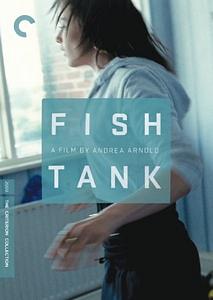It is difficult to generically classify Andrea Arnold’s second feature film, Fish Tank, without omitting something crucial. Undoubtedly an entry in the cycle of British social realist films in the tradition of Ken Loach, Mike Leigh, and Stephen Frears, Fish Tank also combines elements of the melodrama, particularly the women’s film, and the social problem film. Never though, does it ever seem disjointed or piecemeal, a testament to Arnold’s clear vision of gritty lower-class England and her sure, if shaky-realist, directorial hand. The film follows angry 15-year-old Mia (Katie Jarvis) as she wanders aimlessly through the desolate streets of Essex and pugnaciously through various city cliques. She lives in a housing project with her volatile and villainous mother (Kierston Wareing) and her precocious younger sister Tyler (Rebecca Griffiths). Their tiny living space is demonstrative: sparse, half-drunk liquor bottles tossed all over, old clothes draped over the furniture, a refrain of shouted “cunts” and “fucks” ringing always through the tight quarters. Before long, we realize that Mia isn’t in a good place—emotionally or physically.
Prison-like fences, high walls and gates abound in Arnold’s Essex, evoking corresponding feelings of entrapment in the spectator. Claustrophobia is rendered through the domestic clutter that saturates tight frames; while loneliness is signified in the vast, barren wastelands and junkyards that diminish Mia in wide shots. Abiding by the expressive code of melodrama, Mia’s “emotional and psychological predicaments” are perfectly thematized in such settings, sublimating her intense emotions and volatile conflicts into “décor, color, gesture, composition of the frame” (Elsaesser 376). Indeed, there are a number of set pieces that become invested with affect and meaning that Arnold faithfully, and effectively, returns to throughout. A favorite is the apartment’s vertiginous staircase. As Thomas Elsaesser points out, melodrama’s emotional risings and fallings are “invariably played out against the vertical axis of a staircase”; yet, unlike earlier fifties melodramas’ obsession with bourgeois repression, Arnold uses this clichéd mise-en-scène to insinuate the hardships of both emotional and economic deprivation (386). Mia—in paroxysmal fits—clamors up or crashes down this staircase, while the handheld camera thrashes alongside her in correlating hysterics.
Still, despite all the commotion, it is the pervasive silence that commands the mood of the film, imbuing it and its young heroine with a certain unshakeable dread. In this way, Mia is typical of the melodramatic protagonists that precede her: “One sees them helplessly struggling inside of their emotional prisons with no hope of realizing to what degree they are victims of their society” (Elsaesser 392). Indeed, Mia’s inability to recognize the social forces that victimize her literally leaves her speechless, which we—along with the characters that populate Fish Tank—initially mistake for a tough laconism. This façade fails to hold up, though, and, as we learn more, it becomes clear that her silence is actually the byproduct of forces significantly more oppressive and troubling.
Yet, rather than slide into what reviewers often refer to as “Art House miserabilism,” Arnold handles the material in a nuanced, if unflinching, manner. There is certainly a gritty realism that the more squeamish may find difficult; yet, Arnold also provides Mia, and her audience, some relief from her painful social reality by giving her protagonist a “voice” through dance. When the film opens, we see Mia in the final pose of one of her solitary routines. We learn that she aspires to be a background dancer in rap videos and she practice steps multiple times a day. Although it is fairly clear that she lacks any of the requisite ability to be a professional dancer, thus fueling her insecurities and sensitivities, this common teenage ambition nonetheless provides Mia some semblance of agency and a mode of personal expression. Arnold’s subtle storytelling and complex, physically expressive protagonist, in this vein, places Fish Tank as a latecomer in the renowned British film cycle of “Angry Young Men” films, such as Tony Richardson’s Look Back in Anger (1959). Yet, the director’s place as a woman in the largely male tradition of British social realism cannot be overlooked. Arnold brings the visual cues of melodrama to this male-dominated (and nationalist) film tradition in order to shed light on implicit and explicit violence women experience because of class and gender oppression. The result is a film whose stirring power cannot be denied: in 2009, it took home the Jury Prize at Cannes and Outstanding British Film at the BAFTA Awards, among countless other accolades. The Criterion Collection release of Fish Tank, on DVD and Blu-Ray, contains cast interviews, audition footage, and an essay on the film by Ian Christie as well as three short films by Arnold, including the Oscar winning Wasp. Now cemented into film history by the Criterion Collection, Fish Tank will finally—and much deservedly—find an audience this side of the Atlantic.
Reference
Elsaesser, Thomas. “Tales of Sound and Fury: Observations on the Family Melodrama.” Monogram No. 4 (1973): 2-15. Rpt. in Film Genre Reader III, Ed. Barry Keith Grant. Austin: University of Texas Press, 2003. 366-395. Print.
Author Biography
Christian Caminiti is a graduate of Grinnell College. He enjoys reading, watching movies, writing about film, rooting for the NY Giants and playing with his dog, Abbey. He can be contacted at: CRCaminiti7 AT gmail.com
Film Details
Fish Tank (2009)
UK
Director Andrea Arnold
Runtime 123 minutes
DVD
USA, 2011
Produced and Distributed by The Criterion Collection (region 1)












































